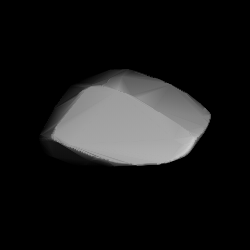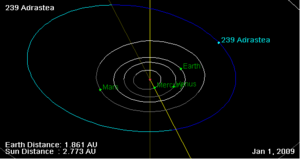Astronomy:239 Adrastea
From HandWiki
Short description: Main-belt asteroid
 3D model based on lightcurve data | |
| Discovery | |
|---|---|
| Discovered by | Johann Palisa |
| Discovery date | 18 August 1884 |
| Designations | |
| (239) Adrastea | |
| Pronunciation | /ædrəˈstiːə/ |
| Named after | Adrasteia |
| A884 QA, 1915 TD 1955 MK1, 1956 UJ | |
| Minor planet category | Main belt |
| Orbital characteristics[1] | |
| Epoch 31 July 2016 (JD 2457600.5) | |
| Uncertainty parameter 0 | |
| Observation arc | 131.66 yr (48,087 d) |
| |{{{apsis}}}|helion}} | 3.66279 astronomical unit|AU (547.946 Gm) |
| |{{{apsis}}}|helion}} | 2.2695 AU (339.51 Gm) |
| 2.96616 AU (443.731 Gm) | |
| Eccentricity | 0.23486 |
| Orbital period | 5.11 yr (1,865.9 d) |
| Average Orbital speed | 17.25 km/s |
| Mean anomaly | 233.617° |
| Mean motion | 0° 11m 34.584s / day |
| Inclination | 6.1746° |
| Longitude of ascending node | 180.634° |
| 210.15° | |
| Physical characteristics | |
| Dimensions | 41.52±1.4 km[1] |
| Rotation period | 18.4707 h (0.76961 d)[1] |
| Geometric albedo | 0.0777±0.006[1] |
| Physics | unknown |
| unknown | |
| Absolute magnitude (H) | 10.4[1] |
Adrastea (minor planet designation: 239 Adrastea) is a main belt asteroid. It was discovered by Johann Palisa on 18 August 1884 in Vienna, and was named after the Greek nymph Adrasteia. This asteroid is orbiting the Sun at a distance of 2.97 astronomical unit|AU with a period of 5.11 years and an eccentricity (ovalness) of 0.23. The orbital plane is tilted at an angle of 6.17° to the plane of the ecliptic.[1]
Photometric data collected during 2009 were used for light curve analysis of this asteroid, yielding a rotation period of 18.48±0.03 h with a brightness variation of 0.45±0.05 in magnitude. The result is close to the 18.347±0.003 h period from a study performed in 2003.[2] The asteroid is roughly 42 km in diameter.[1]
References
- ↑ 1.0 1.1 1.2 1.3 1.4 1.5 1.6 "JPL Small-Body Database Browser: 239 Adrastea". Jet Propulsion Laboratory. https://ssd.jpl.nasa.gov/sbdb.cgi?sstr=239.
- ↑ Carbo, Landry et al. (October 2009), "Asteroid Lightcurve Analysis at the Oakley Southern Sky Observatory: 2008 October thru 2009 March", Bulletin of the Minor Planets Section of the Association of Lunar and Planetary Observers 36 (4): 152–157, Bibcode: 2009MPBu...36..152C.
External links
- The Asteroid Orbital Elements Database
- Minor Planet Discovery Circumstances
- 239 Adrastea at AstDyS-2, Asteroids—Dynamic Site
- 239 Adrastea at the JPL Small-Body Database
 |


